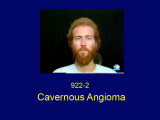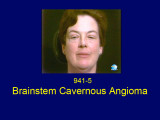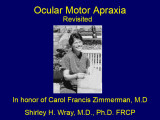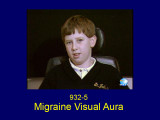Collection of materials relating to neuro-ophthalmology as part of the Neuro-Ophthalmology Virtual Education Library.
NOVEL: https://novel.utah.edu/
TO
- NOVEL981
Filters: Collection: "ehsl_novel_novel"
| Title | Creator | Description | Subject | ||
|---|---|---|---|---|---|
| 151 |
 |
Selective Saccadic Palsy | Shirley H. Wray, MD, PhD, FRCP | This case is published courtesy of Scott D.Z. Eggers, M.D., Department of Neurology, Mayo Clinic College of Medicine (1). The patient is a healthy 50 year old woman who underwent otherwise uncomplicated aortic valve replacement for an incidentally discovered ascending aortic aneurysm. Upon awakening... | Selective Saccadic Palsy After Cardiac Surgery; Supranuclear Gaze Palsy; Ocular Motility; Bilateral Horizontal Gaze Palsy Hypoxia; Pontine Hypoxia; Cerebral Hypoxia |
| 152 |
 |
Cavernous Angioma | Shirley H. Wray, MD, PhD, FRCP | The patient is a 19 year old sophomore who presented in 1983 with numbness of the left hand, involving initially just the fingers, and numbness and weakness of the right side of the face. He described the numbness in his hand as if it was "intensely asleep". The facial numbness involved the perioral... | Unilateral Internuclear Ophthalmoplegia; Unilateral Horizontal Gaze Palsy; Upbeat Nystagmus on Upgaze; Convergence Normal; Pendular Vertical Oscillations; Facial Palsy; Fisher's One-and-a-Half Syndrome; Pontine Hemorrhage; Cavernous Angioma; Unilateral Gaze Palsy Hemorrhage; Abducting Nystagmus; Fac... |
| 153 |
 |
Brainstem Cavernous Angioma | Shirley H. Wray, MD, PhD, FRCP | The patient is a 50 year old woman who presented in November 1977 with a transient facial droop, nystagmus, diplopia, dysarthria and vertigo. She was admitted to New England Tufts Medical Center and had an extensive workup including an electroencephalogram, first generation CT brain scan, angiogram ... | Upbeat Nystagmus; Lid Nystagmus; Horizontal Gaze Evoked Nystagmus; Hiccup; Medullary Hemorrhage; Cavernous Angioma; Bilateral Lid Nystagmus; Bilateral Horizontal Gaze Palsy Hemorrhage; Primary Position Upbeat Nystagmus; Medulla Hemorrhage; Medulla |
| 154 |
 |
Tauopathies (Guest Lecture) | Shirley H. Wray, MD, PhD, FRCP | See also: http://content.lib.utah.edu/cdm/ref/collection/ehsl-shw/id/256, http://content.lib.utah.edu/cdm/ref/collection/ehsl-shw/id/32, http://content.lib.utah.edu/cdm/ref/collection/ehsl-shw/id/81, http://content.lib.utah.edu/cdm/ref/collection/ehsl-shw/id/315, http://content.lib.utah.edu/cdm/ref/... | Global Supranuclear Vertical Gaze Palsy; Convergence absent; Prominent Stare; Slow Hypometric Horizontal Saccades; Slow Horizontal Pursuit; Vertical Oculocephalic Reflex Normal; Positive Glabella Tap; Progressive Supranuclear Palsy; Steele Richardson Olszewski Syndrome; Supranuclear Paralys... |
| 155 |
 |
Tauopathies: A Contemporary Way to Consider a Set of Neurodegenerative Disease Based on Molecular Signature | John Growdon, MD | Slideshow describing condition. | CNS - Degeneration Congenital Ocular Motor Apraxia; Convergence absent; Convergence Insufficiency; Global Supranuclear Vertical Gaze Palsy; Head Thrust; Lid Retraction; Positive Glabella Tap; Progressive Supranuclear Palsy - Tauopathy; Progressive Supranuclear Palsy; Prominent Stare; Pursuit Upgaze... |
| 156 |
 |
Downbeat Nystagmus | Shirley H. Wray, MD, PhD, FRCP | This 58 year old engineer was referred by his neurologist for evaluation of periodic episodes of difficulty focusing and blurred vision for 8 years. In 1981 whilst sightseeing in Newport, he became acutely aware of difficulty focusing and blurry vision. The symptoms lasted for twenty minutes and the... | Downbeat Nystagmus; Oscillopsia; Primary Position Downbeat Nystagmus |
| 157 |
 |
Ocular Motor Apraxia | Shirley H. Wray, MD, PhD, FRCP | Presentation covering an overview of Ocular Motor Apraxia. See also: http://content.lib.utah.edu/cdm/ref/collection/ehsl-shw/id/255, http://content.lib.utah.edu/cdm/ref/collection/ehsl-shw/id/253, and http://content.lib.utah.edu/cdm/ref/collection/ehsl-shw/id/252 | Congenital Ocular Motor Apraxia; Head Thrust |
| 158 |
 |
Whipple's Disease | Shirley H. Wray, MD, PhD, FRCP | A PowerPoint presentation describing Whipple's Disease. | Absent Convergence; Bilateral Lid Nystagmus; CNS Whipple's Disease; Pendular Vergence Oscillations; Somnolence; Supranuclear Paralysis of Up and Downgaze Infection-Whipple's Disease; Supranuclear Paralysis of Up and Downgaze; Tropheryma Whippelii - Infection; Vertical Gaze Palsy (c) |
| 159 |
 |
Migraine Visual Aura | Shirley H. Wray, MD, PhD, FRCP | The patient is a 9 year old right handed boy who developed headaches in 1993 at the age of 8. At that time he told his mother that he had bad headaches starting at the back of the head, usually bioccipital, spreading over the top of the head to his forehead. The headaches were short in duration last... | Migraine Visual Aura without Headache; Metamorphopsia; Macropsia - Hemi-macropsia; Alice in Wonderland Syndrome; Occipital Lobe; Visual Phenomena |
| 160 |
 |
Thalamic Stroke and Disordered Sleep (Guest Lecture) | Shirley H. Wray, MD, PhD, FRCP | See also: http://content.lib.utah.edu/cdm/ref/collection/ehsl-shw/id/299, http://content.lib.utah.edu/cdm/ref/collection/ehsl-shw/id/114, and http://content.lib.utah.edu/cdm/ref/collection/ehsl-shw/id/117 | Somnolence; Global Supranuclear Paralysis of Vertical Gaze; Absent Vertical Saccades and Pursuit Movements; Intact Convergence; Convergence Retraction Nystagmus; Ocular Dysmetria; Ocular Tilt Reaction; Lateropulsion; Unilateral Midbrain and Thalamic Infarct; Supranuclear Paralysis of Up and... |
| 161 |
 |
Upbeat Nystagmus | Shirley H. Wray, MD, PhD, FRCP | The patient, a 36 year old Italian, presented in October 1967, at the age of 27, with acute dizziness and ataxia. He was evaluated in Rome. A pneumoencephalogram showed hydrocephalus, attributed to arachnoiditis, and a ventriculo-atrial shunt was placed. Three months post shunt placement he had a re... | Upbeat Nystagmus; Saccadic Hypermetria; Saccadic Pursuit; Square Wave Jerks; Oscillopsia; Cerebellar Astrocytoma; Primary Position Upbeat Nystagmus; Horizontal Saccadic Dysmetria |
| 162 |
 |
Movement Disorders: A Brief Overview | Albert Yung-Pai Hung, MD, PhD | Slideshow describing condition. | Basal Ganglia; Blepharoclonus; Convergence Insufficiency; Parkinson's Disease- Dopamine deficiency; Saccadic Breakdown of Smooth Pursuit; Slow Hypometric Horizontal Saccades; Slow Hypometric Saccades |
| 163 |
 |
One and a Half Syndrome | Shirley H. Wray, MD, PhD, FRCP | Slideshow describing condition. | Abducens Nuclear Lesion; Abducting Nystagmus; Cavernous Angioma; Convergence Absent; Convergence Normal; Esotropia; Facial Palsy; Facial Weakness; Fisher's One-and-a-Half Syndrome; Gaze Evoked Upbeat Nystagmus; Multiple Sclerosis; Pendular Vertical Oscillations; Pontine Hemorrhage; Pontine Infarct;... |
| 164 |
 |
Optic Disc Drusen (German) | NANOS | Optic disc drusen are abnormal deposits of protein-like material in the optic disc - the front part of the optic nerve. | Optic Disc Drusen; Patient Brochure |
| 165 |
 |
Genetic Information Nondiscrimination Act of 2008 | Senate and House of Representatives of the United States of America in Congress | Law to prohibit discrimination on the basis of genetic information with respect to health insurance and employment. | Genetics |
| 166 |
 |
Animated Lessons on the Neurology of Eye Movements and Pupillary Disorders | Dario Beltran, MD; Douglas Woo, MD; Elliot Frohman, MD, PhD; Steven L. Galetta, MD; Lewis E. Calver, MS; Kim Hoggatt Krumwiede, MA | This interactive training guide correlates clinical eye exams with lesion localization using illustrations, animations, and MRI's to enhance the learning of various common neuro-ophthalmologic lesions that are found in patients with Multiple Sclerosis (MS), stroke, tumor, or infection. Neurologists,... | Pupil Abnormalities; Ocular Movement Abnormalities; Diplopia |
| 167 |
 |
Dry Eye Syndrome (Danish) | NANOS | People with abnormalities of the tear film are diagnosed with "dry eyes", but some patients with "dry eyes" may not feel that their eyes are "dry". Itching, burning, a scratchy sensation, a sensation that there is sand or grit in the eye, or intermittent blurring of the vision can all be symptoms of... | Dry Eye Syndrome; Patient Brochure |
| 168 |
 |
Central Retinal Artery Occlusion | Natasha Nayak, MD; Rudrani Banik, MD | Power point of case presentation of acute central retinal artery occlusion (CRAO) treated with tPA. Risk factors for stroke and results of EAGLE study reviewed. Imaging: Number of Figures and legend for each: 12 Slide 3: Figure 1: Table 1: Exam Findings Slide 3: Figure 2: Table 2: Exam Findings Cont... | Central Retinal Artery Occlusion; Stroke; Tissue Plasminogen Activator; EAGLE Study |
| 169 |
 |
Pseudotumor Cerebri - Large Print | NANOS | This is a condition in which high pressure inside your head can cause problems with vision and headache. | Pseudotumor Cerebri; Patient Brochure |
| 170 |
 |
Pseudotumor Cerebri (Spanish) | NANOS | This is a condition in which high pressure inside your head can cause problems with vision and headache. | Pseudotumor Cerebri; Patient Brochure |
| 171 |
 |
Pseudotumor Cerebri (Hebrew) | NANOS | This is a condition in which high pressure inside your head can cause problems with vision and headache. | Pseudotumor Cerebri; Patient Brochure |
| 172 |
 |
Pseudotumor Cerebri | NANOS | This is a condition in which high pressure inside your head can cause problems with vision and headache. | Pseudotumor Cerebri; Patient Brochure |
| 173 |
 |
Thyroid Eye Disease (Thai) | NANOS | This is an autoimmune condition where your body's immune system is producing factors that stimulate enlargement of the muscles that move the eye. | Thyroid Eye Disease; Patient Brochure |
| 174 |
 |
Thyroid Eye Disease-Tagalog | NANOS | This is an autoimmune condition where your body's immune system is producing factors that stimulate enlargement of the muscles that move the eye. | Thyroid Eye Disease; Patient Brochure |
| 175 |
 |
Thyroid Eye Disease (Korean) | NANOS | This is an autoimmune condition where your body's immune system is producing factors that stimulate enlargement of the muscles that move the eye. | Thyroid Eye Disease; Patient Brochure |
